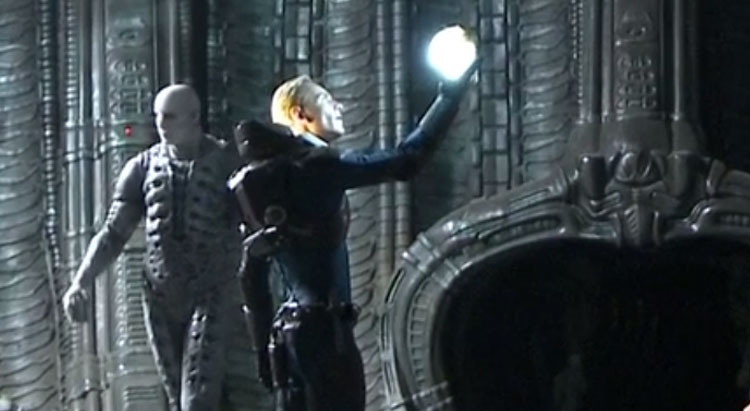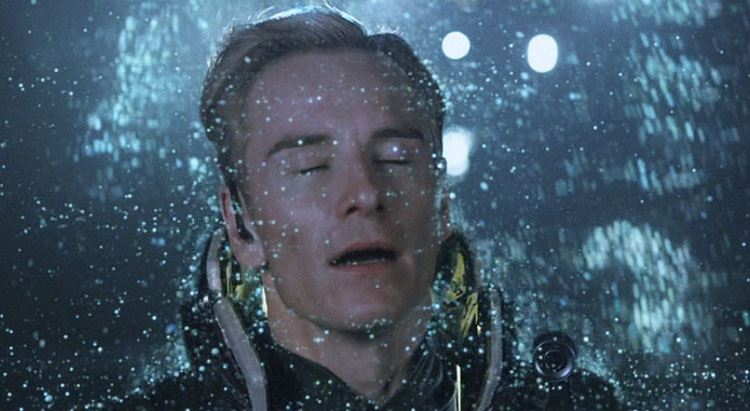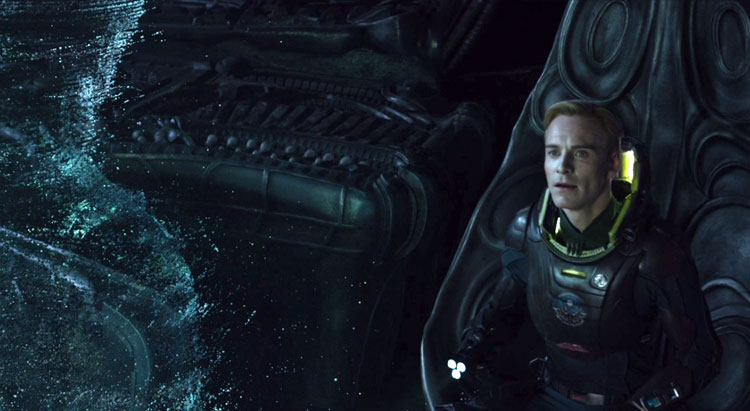
|

|

|

|

|

|

|

|

|

|

|

|


David, a Weyland Corporation android on board the Prometheus, undertakes his own detective work into the Engineers and uncovers a three-dimensional star map inside the Orrery actually the Engineers' spacecraft control room. Fuel VFX in Sydney created the star map often relying on deep compositing techniques as well as scenes of the Holotable on the Prometheus bridge and holographic video recordings of the Engineers inside the dome, the Orrery's control desk effects, the laser scanning probes or 'pups', holographic screens in Vickers' suite and set extensions.
The Orrery star map, in particular, drew upon art department designs and extensive Fuel concepts. "The original logic of how it's laid out was a big bang," explains Fuel visual effects supervisor Paul Butterworth. "We used a fluid simulation to figure out and map out the threaded fluid that's exploded out to the volume. Then we used that logic to place each of the nebulas and star cluster. The logic was that you could pick any star system and blow it up into a section that you could study. Every nebula in there is a frozen moment of a fluid sim that's been run over its course and found that right moment."
Production filmed David (Michael Fassbender) on set in the cavernous 007 stage at Pinewood interacting with some occasional props and interactive lighting. The set was Lidar'd to enable set extensions, further shots involving the holographic Engineer projections and also the emergence of the 'space jockey' chair which Weta handled.

Fuel incorporated Nuke's deep compositing tools into its pipeline for the complicated Orrery shots, and for others, often enabling fast turnaround times for revisions since the planet, star animations and gas cloud sims would not have to all be re-rendered. "We also wrote a bunch of tools that can reference the shot you're working on in Nuke and bring in only the stuff you need right now, or bring in the assets for that shot," says Fuel compositing supervisor Sam Cole.
A significant amount of work was required in preparing the plates for the star map effects, by removing the distortion from the plates and also solving for stereo. "Say your camera's a totally non-VA (vertically-aligned)," explains Cole, "then you're getting parallax between these very fine star fields and your pixel you can touch on the screen is the sum of all the pixels behind it and you have a vertical alignment matte you can rubber sheet that around. You can push that one pixel around but you've got baked parallax."
The Prometheus crew encounter Engineer video holograms while inside the dome, essentially old recordings played back in a point-cloud-like re-projection. For these shots, Fuel had motion capture data of the Engineer performers and experimented with the ultimate final look. "The idea with the Engineers was that they were security recordings," says Butterworth. "If you're able to record all the actions of all the Engineers going about your business in a volume as a 3D object over thousands of years they become degraded and broken up. Half of the pixels aren't working within the volume anymore. We looked at old TVs and other reference taking a perfect recording of an Engineer and deteriorating it."
Using the tunnel Lidars, Fuel executed one scene of the Engineers running past and through David. "Ridley drew these pictures where as the Engineer wrapped around him some of his texture wraps around his surface," comments Butterworth. "It was roto-matted light passes to re-light David for that pass."

Inside the Orrery, where David sees a holographic projection of the Engineers operating the control desk, and later the Engineer operates the 'space jockey' chair, Fuel created both graphics for the desk and the star map, sharing shots with Weta Digital.
"We had to replace the desk," says Butterwoth. "We had a beauty run of the desk, in some cases painting out an Engineer shot in stereo and then painted out the backplate. The scene was originally going to be shot with motion control but it was long and laborious to set up and the shots can feel very mechanical. So at some point they shot with normal live action using crane moves, Steadicam and dolly moves. They did poor man's motion control where they got your actor, he'd then pull out the Engineer and play to the space where he was. And sometimes they'd shoot a clean plate. There'd be some cases where the Engineer would be in shot, and because the eyeline's better you inevitably have to paint it out and remake a backplate."

Fuel had the benefit of The Foundry's head of research Jonathan Starck visiting the studio to help with R&D and getting on an alpha version of Ocula (now a released product). Another helpful tool was Peregrine Labs' defocus tool Bokeh, produced by Colin Doncaster. "In all of our renders that were coming out deep," says Cole, "they were coming out sharp so we were able to match the focus later in comp with Bokeh. Inside the Orrery we wanted to have full control over the exact shape of the bokeh and the slight chromatic searing that you would get on those discs. And that allowed us to do it in deep. We'd plug in the cameras, plug in the T-stop from the on-set sheet and that's where we start. It was fantastic for that. A lot of the iterations we would have been really stuck without being able to iterate with that, especially for the Engineers where all the points are coming off the ground in the storm that are coming off them."
